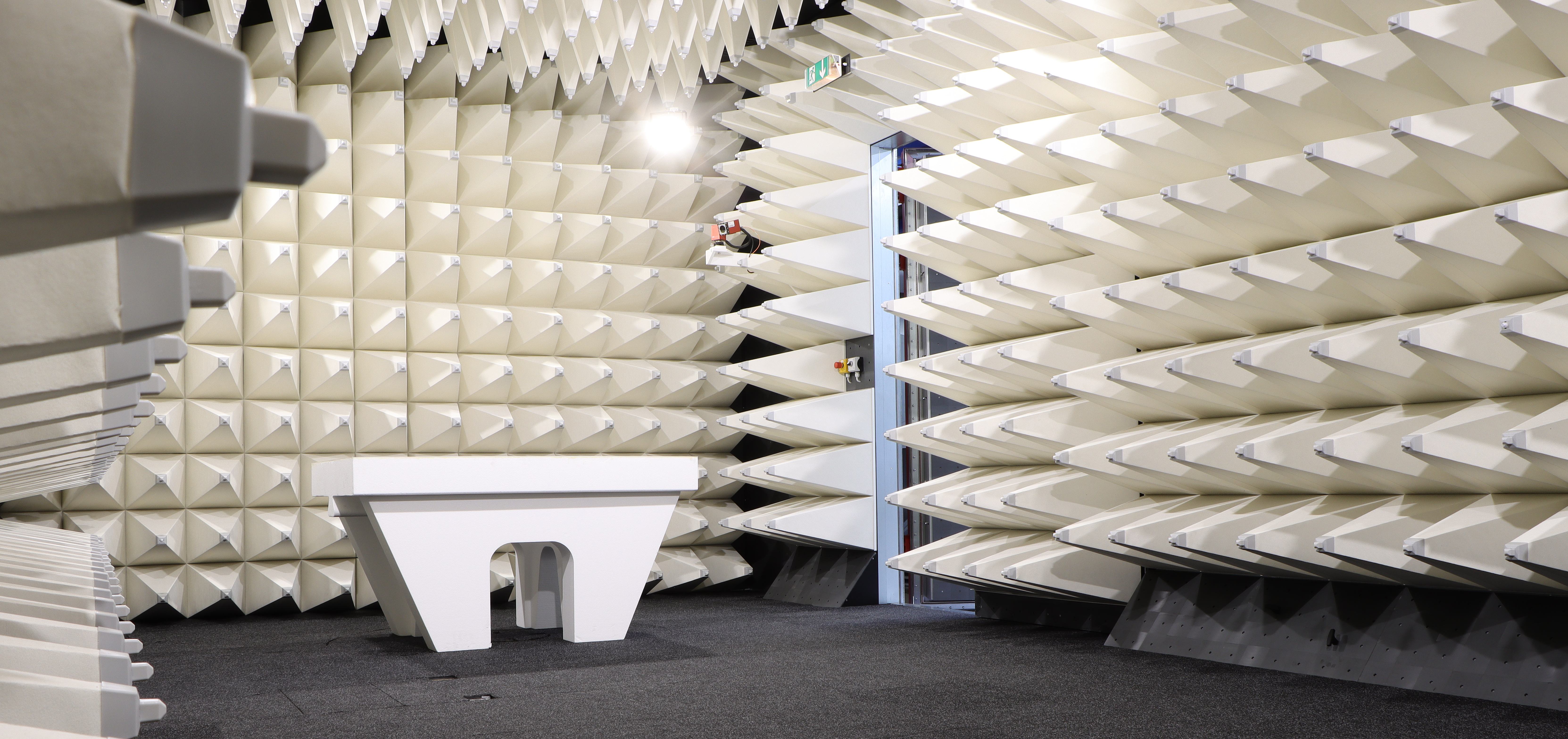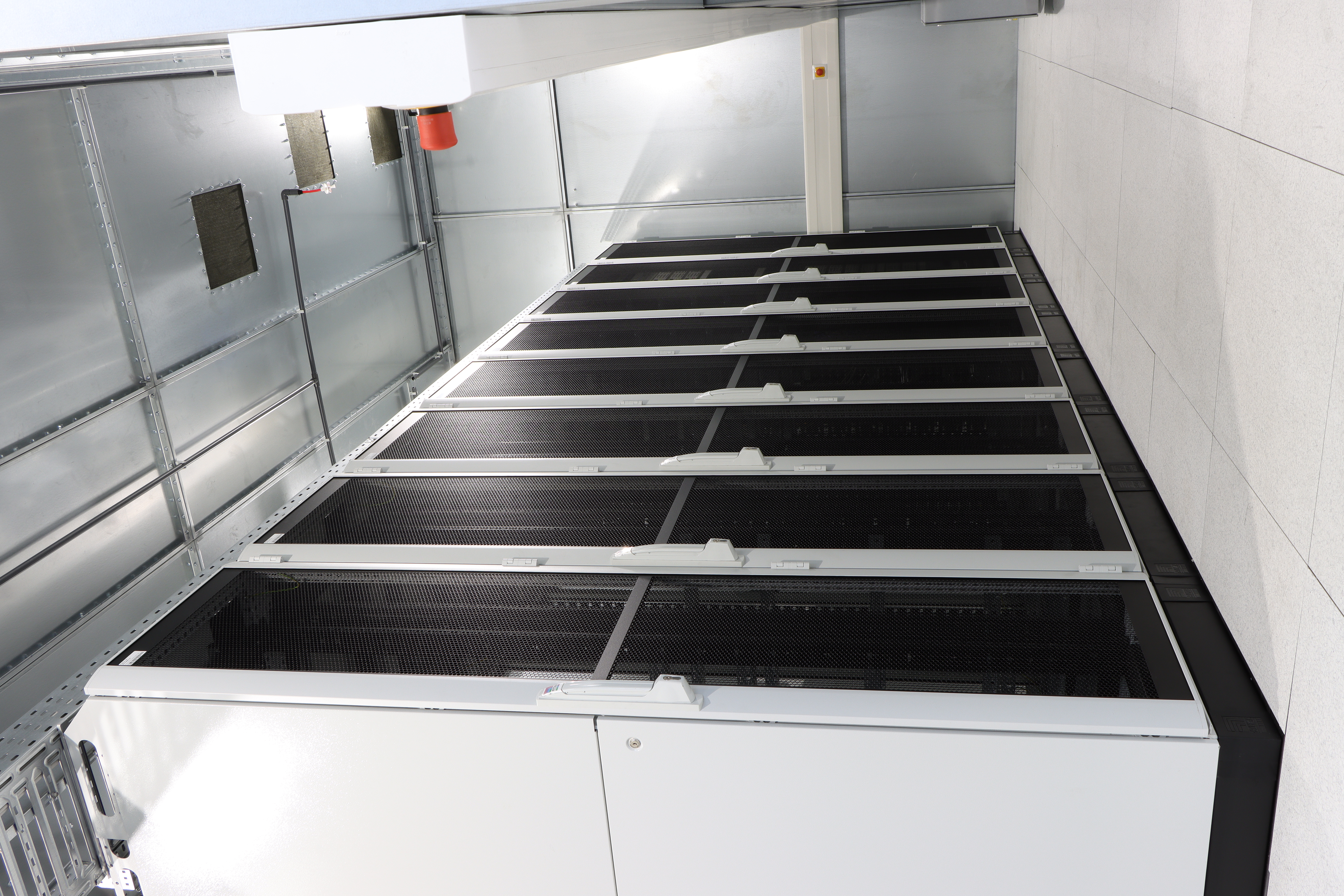Author: Dr. Marian Lanzrath
Construction of a new experimental hall that houses an anechoic chamber for experimental EMC tests and a shielded room for the centralized operation of HPM sources.
In order to be able to comprehensively investigate electrical devices’ interference resistance to high-power electromagnetic waves and their emitted interference, Fraunhofer INT has been equipped with several test environments and a range of signal sources as well as measuring equipment to support technical progress. An application was made to the internal Fraunhofer funding program for financial support to establish a new experiment hall with a view to systematically supplementing this portfolio of facilities. This new experimental hall comprises an anechoic chamber, which will primarily be used for standard electromagnetic compatibility (EMC) tests for electronic devices as well as EMC tests for automotive applications, and a shielded room for the operation of high frequency sources. By housing these facilities in one central location, the entire source portfolio can be flexibly and efficiently used in all test environments.
Planning/Construction phase
Planning and construction for the new experimental hall and its technical equipment took several years. The project’s biggest challenges were notably planning the installation areas for the two shielded rooms due to limited available space and meeting other specific requirements, including the very high degree of planarity of the rooms’ installation surface, the necessary climate control for the high frequency amplifiers and the supply of their electrical connected load. In terms of the actual construction of the experimental hall, there were constant delays despite detailed planning due to, for example, unexpected discoveries during civil engineering works and the Covid-19 pandemic.
Technical properties of the new chambers
To protect the surrounding environment, the electromagnetic fields emitted during device sensitivity tests must not be radiated outwards, which is why the walls of the new anechoic chamber must be tightly sealed against electromagnetic waves. The inside of the chamber is also lined with absorbers that absorb electromagnetic waves. It has the flexibility to be converted into either a fully anechoic chamber (FAC) or a semi-anechoic chamber (SAC) and can be used for many standardized EMC test procedures. For the latter operating mode, the modularly designed floor absorbers are removed, whereby reflections on the ground that occur in real life situations when a device is exposed to radiation outside are simulated. In addition, the chamber is suitable for supporting the business unit’s other fields of activity, such as measuring antenna and custom-made field probes.
The new hall is also designed in such a way that all high-power sources available in the laboratory can be combined in a new amplifier chamber. Their central position in the laboratory area makes it possible to position all available test environments in close proximity next to the immediately adjoining new anechoic chamber and to provide a flexible switch matrix with the required test signals. The short cable paths minimize signal loss, which benefits the peak field strength that can be produced for the tests. The walls of the amplifier chamber are designed with the same shielding structure as the anechoic chamber because interfering radiation can result in the surrounding environment when operating high-power amplifiers. Due to waste heat being produced at the same time, efficient climate control must also be ensured.
Technical equipment
Modular metallic exterior walls achieve the fundamental shielding effect for both chambers. On the inside of the anechoic chamber, a full-surface lining of ferrite and pyramid absorbers also reduces unwanted reflections up to frequencies of 40 gigahertz. A turntable with a diameter of 1.5 meters and a load capacity of 500 kilograms as well as an antenna mast with automated polarization switching are also installed. In addition, the anechoic chamber is equipped with GPS signal simulators for test specimens and fitted with special-purpose cameras for visual monitoring of the experiments. There is also fiber optic-based communications technology enabling observation of the inner workings of the test specimens via accessible data interfaces.
In order to be able to operate all high frequency sources in the amplifier chamber, this has an electrical connected load of 86 kilowatts. All cables running into the chamber are equipped with high frequency filters and climate control similar to that in a server room ensures that the waste heat produced by the equipment is removed. The high frequency sources, their control units and extensive switching equipment can be installed in nine 19-inch server racks.
Benefit for the EME business unit
The anechoic chamber expands the test environments that have been operating for many years at the business unit, which include the electromagnetic reverberation chamber, TEM waveguide, a bulk current injection (BCI) setup and a small anechoic chamber that enables tests with and on antenna, comprising a floor with changeable reflective properties and a measuring distance of up to three meters. By lining the entire anechoic chamber with ferrite and pyramid absorbers (individually configured for use as an FAC or SAC), standards- based compliance and pre-compliance EMC tests in a frequency range of up to 40 gigahertz can be performed in the chamber; such a high frequency range is increasingly relevant for applications. In addition, the business unit’s previous activities, such as measuring antenna or custom-made field probes, can now be carried out much more efficiently and extensively.
Upcoming work in 2021
Following the handover of the laboratory area, commissioning the anechoic chamber as a new measurement environment is on the agenda for 2021. The technical equipment for the amplifier chamber also needs to be installed and commissioned. In addition, a new measuring station as well as storage areas for the necessary equipment and floor absorbers (when the chamber is being used as a SAC) are being built in front of the anechoic chamber. Furthermore, work on the existing test environments must also be carried out so that the signal pathways from the amplifiers to the test environments are as short as possible. To that end, the large TEM waveguide — measuring approx. 12 meters in length and around four meters in width and height — must be rotated 180° within the existing shielded hall. To accomplish this, the waveguide must first be disassembled into three subsections; these must then be individually rotated and moved to their final installation position before being reassembled. The electromagnetic reverberation chamber must also be moved in its entirety to the opposite corner of the shielded hall. After relocation to the new places of use, both test environments must be subsequently recommissioned and validated. Last but not least, the working group is planning work to digitalize the laboratory, which notably includes the automation of signal generation and distribution as well as the automation of measurement routines.
 Fraunhofer Institute for Technological Trend Analysis INT
Fraunhofer Institute for Technological Trend Analysis INT

